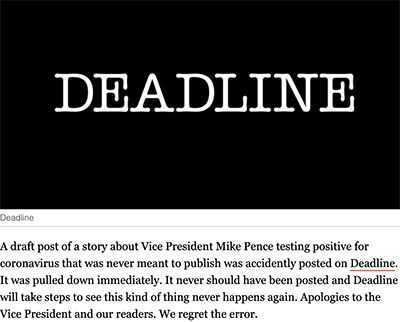Carl Corry
The headline from a link forwarded to me by a relative on October 8 from the online news outlet Deadline read: “PREP. DO NOT PUBLISH UNTIL THE NEWS CROSSES. Vice President Mike Pence Tests Positive for Coronavirus 8 Days After Donald Trump.” I was both surprised and skeptical, given the odd nature of the headline text itself and the fact that I had not received notifications from any other major news outlets about such high-priority news. If it was Deadline’s scoop, okay; I figured it was fair to give the other operations time to catch up. But I had to check. After a quick search, I found that news outlets like The New York Post and The Hill posted stories noting that Deadline had mistakenly published a draft story incorrectly stating that the vice president had tested positive for Covid-19. Then Deadline itself issued an apology: “It never should have been posted and Deadline will take steps to see this kind of thing never happens again,” the statement said. “Apologies to the Vice President and our readers. We regret the error.” In this case, Deadline made an error. But when social media heightens the chances for misinformation to spread, as we have seen many times in recent years, and at a time when solid journalism is crucial prior to a national election, how do you avoid falling into to the trap that my relative did in believing false information to be true? I’ve been teaching a class for the last year called Judging the News, modeled after Stony Brook University’s groundbreaking news literacy program, that provides students with the tools to be good news consumers. Some of what they learn I shared above by describing how I followed up on Deadline’s dubious headline. As we tell our students, the burden is on news consumers to serve as our own fact-checkers—to have our own verification process so that we can find and share reliable information. So, how do you do that?
Keep these tips in mind, and you’ll be on your way to becoming a champion news consumer. |
